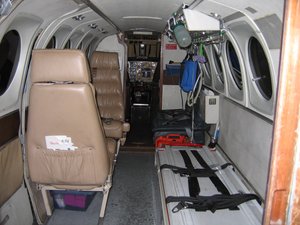Air ambulance
|
|
FDF_talavera_PJS.jpg
Londonairambulance.jpg
Joel.JPG
An air ambulance is an aircraft (often a helicopter) that is used for emergency medical assistance in situations where a road ambulance cannot easily or quickly reach the scene. Usually an air ambulance is equipped with material which enables the crew to give a first adequate medical treatment to a critically injured or ill patient. This mostly includes for example a respirator, medicines, an ECG and monitoring unit, CPR equipment, a stretcher, etc.
The medical crew normally consists of one or more paramedics but is mostly joined by a flight nurse or a physician who has been specially trained for this duty. Who exactly forms the crew with which qualification depends on the regional structure of the emergency medical assistance which the air ambulance usually cooperates with. On many air ambulance, pilots with immense experience in avionic matters and flight business are occupied. This is required because the conditions of air ambulance flights are often much less convenient than regular non-emergency flight services.
The first air ambulance service was established in outback Australia, in 1928, an organisation that became the Royal Flying Doctor Service.
Private sector Air Ambulances are quite expensive and therefore travelers who may need the service need to purchase adequate travel insurance with a high enough medical evacuation benefit to pay for such emergency transport services, should the need arise. It is better to travel insured and have an assistance company negotiate on your behalf with the air ambulance provider than to deal with the air ambulance company directly as an (uninsured) individual. The assistance company has the authority from the travel insurance company (pending verification of coverage) to pay the provider directly, and can usually negotiate a better rate than private individuals. However, the assistance company is bound to follow the insurance policy guidelines exactly, which usually stipulate the transport must be medically necessary, and requires transporting the patient to the nearest adequate medical facility, which is not necessarily the patient's home hospital in many cases. Some travel policies can be purchased as annual, renewing memberships and allow insureds to choose destinations for air ambulance transports, but these are rare and more expensive than policies purchased to cover individual trips.
Publicly-owned air ambulance service is provided by the US Coast Guard and other agencies in certain areas, usually at no direct cost to the individual; transport is usually by helicopter and involves shorter distances than privately owned air ambulance jets.
Depending on the equipment, crew composition, and condition of the patient, there is sometimes room for one passenger, usually a next-of-kin of the patient, and 1 carry-on bag. Space is very limited, so next-of-kin should be prepared to follow the air ambulance by commercial air travel if necessary.
Every year an Air Ambulance Show is held in the Czech Republic.
A partial listing of air ambulance service providers can be found here: [1] (http://web.nbaa.org/public/marketplace/products/?AIR_AMB_:Air_Ambulance_Services_)
and here: [2] (http://travel.state.gov/travel/tips/health/health_1185.html)
See also
External link
Air Ambulance Services information site (http://www.air-ambulance-services.org)

